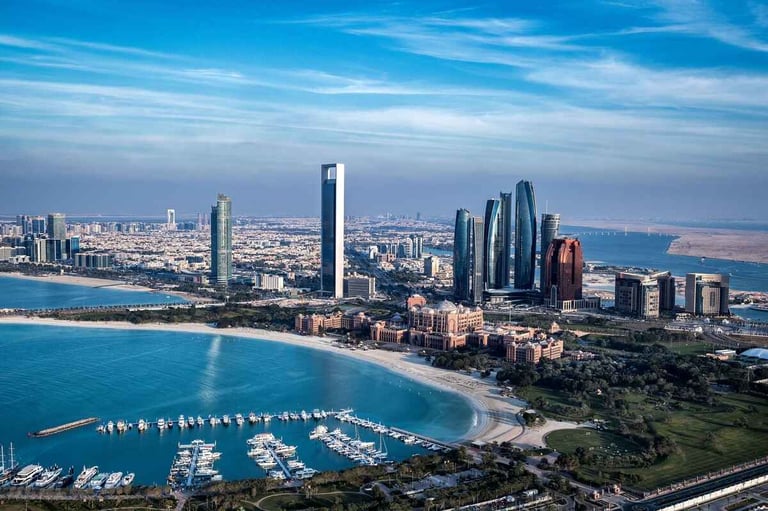As the global economic landscape braces for uncertainty in the wake of rising U.S. tariffs and mounting tensions, questions around growth, inflation and the future of globalization are coming to the forefront.
At the 19th annual EFG Hermes one-on-one conference in Dubai, we speak with Mohamed Abu Basha, managing director and head of macroeconomic analysis at EFG Hermes, who offers key insights into what lies ahead for the global economy and how the MENA region can position itself for growth amid global market volatility.
From the growing risk of a U.S. and global recession to the broader implications of a breakdown in global trade norms, Abu Basha sheds light on the macroeconomic signals that matter and the sectors likely to withstand the turbulence.
How would you characterize the global growth outlook for the remainder of 2025? Are we looking at a soft landing or further turbulence?
With the announcement of U.S. tariffs on the 2nd of April, the outlook has shifted towards a recession in the U.S. and globally because this move was much more aggressive and broader than expected.
The odds now are shifting more towards a recession if these tariffs are here to stay, and we don’t see any backing down in the next few weeks.
How will Trump’s tariffs affect the U.S. and global economies?
Trump’s tariffs are a huge hit to all the principles and standards of global trade that have dominated the global economy since World War II. It’s a huge hit to both markets and people, and when trying to account for the impact on profitability and margins. These tariffs are also raising bigger questions about how countries will trade and exchange.
For the U.S. and the world, we can see a base case of stagflation emerging. Higher inflation is expected as a result of the tariffs. However, prices may be cushioned by the sharp drop in commodity prices in general and oil prices in particular.
This case is different from the stagflation witnessed in the 1970s. However, higher inflation will lead to lower growth, which is different from what we had seen in the past three to four years, where both inflation and growth were higher.
Eventually, this base case may lead to lower interest rates and a weak USD. For the U.S. and the global economy at large, tariffs will increase the odds of a recession.
Could this new wave of tariffs mark a broader shift away from globalization as we know it? Are we witnessing the early stages of a structural transformation in global trade dynamics?
This new wave of tariffs has shaken all the principles and foundations of not only globalization but also the global trade system as we knew it since the end of World War II, and this is what is unnerving markets.
It’s a trade war, and wars typically end with a winner and a loser. Who will compromise, and who will dictate the new terms? This is the uncertainty that the market typically hates, even more so when it’s impacting such a foundation as global trade because global trade has been, to a large extent, shaping the global economy and growth dynamics for the better part of the last 60 years or even more.
For instance, the rise of all the Asian markets was fundamentally based on trade and exchanging goods with the rest of the world. Therefore, markets are now speculating what the impact of those tariffs will be. Will the world have a new trading system, or will the current system stall? If so, economies globally will face less trade, growth and employment.
Until these questions are answered, the market will remain very tense.
How do you see Egypt and the GCC economies navigating structural reforms versus short-term growth pressures?
For the region, what’s happening is offering some opportunities. The region is not very entrenched in global supply chains, and it’s not heavy on exports outside of energy, which has been excluded from the tariffs.
The latest tariffs are a confirmation that governments need to keep focusing on reforms. The Gulf region needs to keep pushing harder in its transformation. With global volatility around oil, governments should push harder to diversify their economies.
Meanwhile, Egypt has the opportunity to attract more investments. A trend that has emerged since COVID-19 is nearshoring, where companies are moving supply chains closer to home and reshuffling manufacturing hubs. In Egypt, this can offer a good opportunity to attract investments.
Read: How GDMO embraces trends, tech and AI to weave Dubai’s narrative
What sectors or asset classes in MENA look most compelling from a macroeconomic lens right now?
The best thing investors want now is something that’s more domestically focused and domestically driven to avoid the noise of what’s happening. We favor the financial sector as well as the property sector.
For example, both sectors in Saudi Arabia and the UAE are domestic and demand-driven. Saudi Arabia is inviting more people to invest in key sectors, including religious tourism, which is completely isolated from all the current noise at the global level. These countries will need to finance these different plans now more than ever because governments will be somewhat stretched. The ability to finance growth will be a growing burden on banks and financial companies.
Another key sector is logistics and utilities since it feeds the demand of a higher population, which will be to a large extent, resilient.
At the end of the day, it’s always important to understand that in wars, there are not many winners. However, with investments, it’s all relative to what sector investors want to focus on. Therefore, these are some domestic demand-driven sectors that avoid the current volatility in global markets.
Markets have now adjusted lower, so investors are adjusting their growth scenarios. This volatility and the drop in prices, however, offers great opportunities. Investors can now start to plug in or look for more reasonable growth than previously since things have changed. The underlying dynamics and growth drivers have not been impacted, in my view, with what’s happened. Therefore, the region can still offer interesting opportunities for investors.








